Chapter: Biotechnology: Plant Cell Culture and Applications
Transgenic plants with beneficial traits

Transgenic plants with beneficial traits
During the last couple of decades, considerable progress has been made to understand the function of genes, isolation of novel genes and promoters as well as the utilization of these genes for the development of transgenic or genetically modified (GM) crops with improved and new characters. There are many potential applications of plant genetic engineering and some important examples of transgenic crops, approved by the U.S Food and Drug administration are summarised in Table 2.
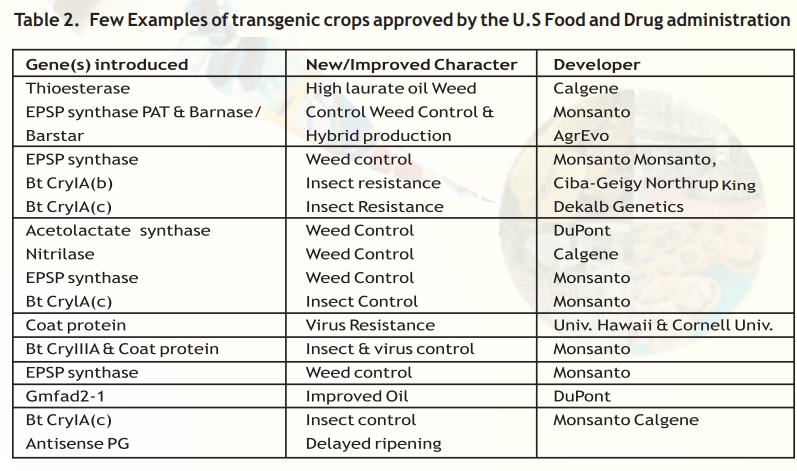
Stress tolerance
Crop plants are very productive under ideal cultural conditions, but ideal growing conditions rarely occur. Moreover, plants encounter both biotic (viral, bacterial, fungal pathogens, nematodes, insect pests and weeds) and abiotic (salinity, drought, extreme temperatures, nutrient deficiency, etc.) stresses and these stresses cause a colossal loss of crop yield and quality. The application of chemical and biological pesticides as well as the use of resistant varieties is only partial success and these have certain limitations. Therefore, newer and effective technologies are essential to meet the demand. In this context, biotechnological strategies can be used to create transgenic plants with increased resistance to diseases and pests as well as abiotic stresses.
Biotic stress tolerance
Herbicide tolerance: Weeds (plants growing where they are not wanted, e.g. Striga) decreasecrop yields and quality primarily by competing with crop plants for light, water and nutrients. Farmers apply herbicides/weedicides (e.g. glyphosate) for the eradication of weeds in the fields, but the main problem with this is the development of herbicide tolerance by weeds. Newer techniques, based on biotechnological tools, have been developed which are quite effective for weed management as well as in increasing the yields and income. There are several biotechnological strategies for weed control, but the most commonly employed approach is the over-production of herbicide target enzyme (usually in the chloroplast) in the plant, so that it becomes insensitive to the herbicide. The popular example for such an approach is the introduction of a modified gene from an Agrobacterium species that encodes for a resistant form of the herbicide target enzyme into crop plants for tolerance against the most extensively used herbicide glyphosate (sold as Roundup) and is effective against many weeds. Roundup Ready GM crop plants such as canola (Fig. 9A), soybean, corn and cotton tolerant to glyphosate has already been commercialised.
Pest resistance: All crop plants are affected by a variety of insects and nematodes, andsignificantly reduce their yield and quality. To minimize these losses (both food and money), farmers use the synthetic pesticides extensively which cause severe effects on human health and environment. The transgenic technology provides an alternative and innovative method to improve pest control management which are eco-friendly, effective, sustainable and beneficial in terms of yield. The first genes available for genetic engineering of crop plants for pest resistance were Cry genes (popularly known as Bt genes) from a bacterium Bacillus thuringiensis.
These are specific to particular group of insect pests, and are not harmful to useful insects like butter flies and silk warms. Transgenic crops (e.g. cotton, rice, maize, potato, tomato, brinjal, cauliflower, cabbage, etc.) with Bt genes have been developed for and such transgenic varieties proved effective in controlling the insect pests and it has been claimed worldwide that it has led to significant increase in yields, and dramatic reduction in pesticides’ use. Bt crops have already been commercialised in several countries. The most notable example is Bt cotton (which contains CryIAcgene) that is resistant to a notorious insect pest Bollworm and in the year 2002, Bt cottonwas adopted in India (Fig. 9B).
Disease resistance: Pathogens (viruses, fungi and bacteria) infect crop plants and drasticallyreduce their yield and quality. Globally, several diseases have caused havoc at several points of time in several countries. For instance, the great Irish famine resulted in great damage of potato crop due to the late blight disease caused by fungal pathogen. India has also experienced a famine in the form of Bengal famine due to destruction of rice caused by fungal pathogen. Thus, there is a great concern about the control of plant diseases. Traditionally, farmers apply chemical pesticides or use resistant crop varieties developed by the breeders, but these methods have certain limitations.The alternative and useful strategy is the creation of disease resistant transgenic crop plants by transfer of resistance genes from varied sources.
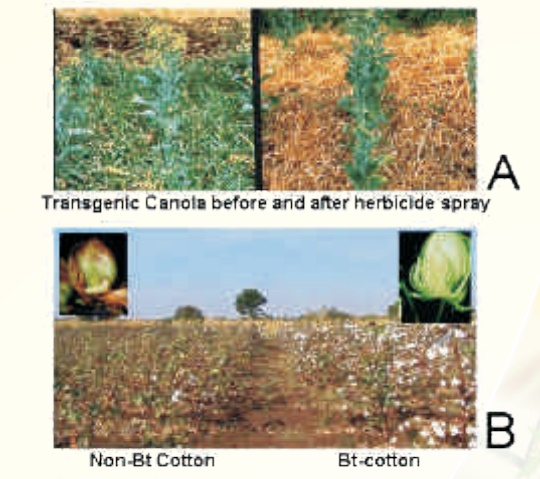
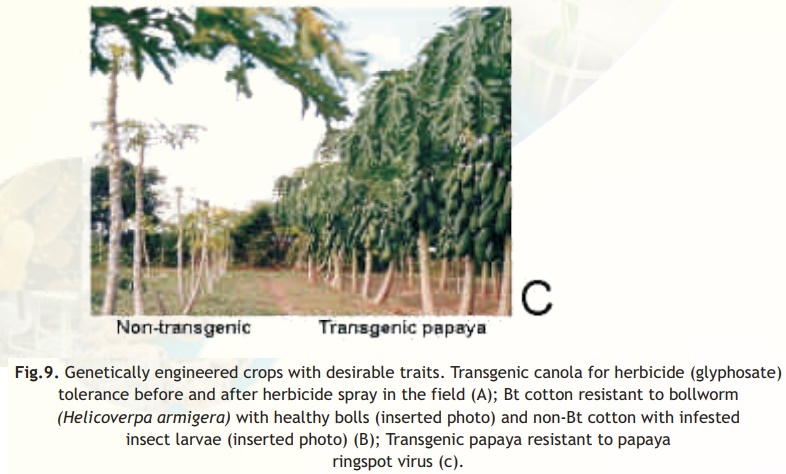
Virus resistance: There are several strategies for engineering plants for viral resistance, andthese utilizes the genes from virus itself (e.g. the viral coat protein gene). The virus-derived resistance has given promising results in a number of crop plants such as tobacco, tomato, potato, alfalfa and papaya. Some viral resistance transgenic plants like papaya resistant to papaya ring spot virus (Fig. 9C) have been commercialised in some countries.
Fungi and bacteria: Plants respond to pathogens by inducing a variety of defence responses likepathogenesis-related proteins (PR proteins), enzymes that degrade/destroy fungal cell wall, antifungal proteins and compounds, phytoalexins, etc. Several transgenic crop plants showing increased resistance to fungal pathogens are being raised with genes coding for the different compounds mentioned above.
Some of these strategies, particularly the genes that encode for phytoalexins and cell wall degrading enzymes were also used for producing bacterial resistant transgenic plants.
Abiotic stress tolerance
Plant growth and productivity are greatly affected by various environmental stresses/ abiotic stresses like high salinity and drought. Plant breeding efforts to produce abiotic stress tolerant plants while retaining high production is not very successful.
Plants have evolved many types of adaptations to cope with abiotic stress conditions like the production of the stress-related osmolytes like sugars (e.g. trihalose and fructans), sugar alcohols (e.g. mannitol) and amino acids (e.g. proline), glycine betaine, and certain proteins (e.g. antifreeze proteins). Transgenic plants have been developed which over-express the genes for one or more of the above mentioned compounds. Such plants have shown increased tolerance to environmental stresses.
Delayed fruit ripening
The gas hormone, ethylene is involved in the regulation of fruit ripening. Therefore, ripening can be slowed down by blocking or reducing ethylene production. This can be achieved by introducing ethylene forming gene(s) in a way that will suppress its own expression in the crop plant. Fruits from such plants ripen very slowly (however, they can be ripen by ethylene application) and are very important for export to longer distances without spoilage as they show longer-shelf life due to slow ripening. The notable example of this kind is the 'FlavrSavr' transgenic tomatoes which were commercialized in U.S.
Male sterility
Male sterile plants are very important to prevent unnecessary pollination and to eliminate the process of emasculation during the production of hybrid plants. These are created by introducing a bacterial gene from Bacillus amyloliquefaciens that encode an enzyme barnase, which is an RNA hydrolyzing enzyme that inhibits pollen formation if, the expression of this gene specifically in the tapetal cells of anther using tapetal-specific promoter (e.g. TA29) to restrict its activity only to the cells involved in pollen production. Male fertility can be restored by introducing another gene from the same bacterium under the control of TA29, whose product barstar(protein) tightly bind with RNase, so that the normal pollen are formed. This barnase/barstar system was successfully utilized in producing male sterile/restorer lines in number of crops, particularly mustard for hybrid production.
Transgenic plants as bioreactors (Molecular farming)
Plants are amazing and cheap chemical factories that need only water, minerals, sun light and carbon dioxide to produce thousands of sophisticated chemical molecules with different structures. Given the right genes, plants can serve as bioreactors to modified or new compounds such as amino acids, proteins, vitamins, plastics, pharmaceuticals (peptides and proteins), drugs,enzymes for food industry and so on. Some of the potential and remarkable examples of this kindare described here.
Nutrient quality
Plants are the principle source of human nutrition. A small number of crop plants such as cereals, legumes, vegetables and root crops supply most of the energy and nutrients (in the form of fats, carbohydrates, proteins, vitamins and micronutrients) in the human diet. It is estimated that about 800 million people, mostly in developing countries are malnourished (particularly children) and suffering with several diseases due to the deficiency of nutrients. Therefore, the improvement of nutritional quality of crop plants is extremely important. Transgenic crops with improved nutritional quality have already been produced by introducing genes involved in the metabolism of vitamins, minerals and amino acids. Few examples of genetic modification of nutrition quality are described below.
Vitamin A: The source of vitamin A is either directly from animal food (e.g. milk, cheese andmeat) or indirectly from green leafy vegetables (e.g. carrots, spinach, tomatoes, and chillies) and fruits (e.g. mango, melon and papaya), which contain carotenoids (beta-carotene - the provitamin A) that are converted to vitamin A in the body. Vitamin A deficiency can lead to night blindness, permanent blindness and skin disorder, among others. About 124 million children worldwide are deficient in vitamin A and a quarter of a million go blind each year due to vitamin A deficiency.
The staple food rice is extremely low in vitamin A, and therefore the improvement of vitamin A content is very important. In a remarkable example of genetic engineering, Prof. Ingo Potrykus and Dr. Peter Beyer developed genetically engineered rice (popularly known as 'Golden Rice'), which is enriched in pro-vitamin A (beta-carotenoids) by introducing three genes involved in the biosynthetic pathway for carotenoid under the control of endosperm-specific promoter, so that gene products (enzymes) are synthesized in the rice endosperm. The seeds of Golden Rice are yellow in colour because of pro-vitamin A is produced in the entire grain (Fig. 10A). Interestingly, they have also further engineered this Golden Rice by introducing three more genes from different organisms for iron source and its absorption. Similarly, transgenic crop plants are also being produced to raise the level of other vitamins, particularly vitamin E (which is an essential antioxidant in humans) and vitamin K (which is involved in bone formation).
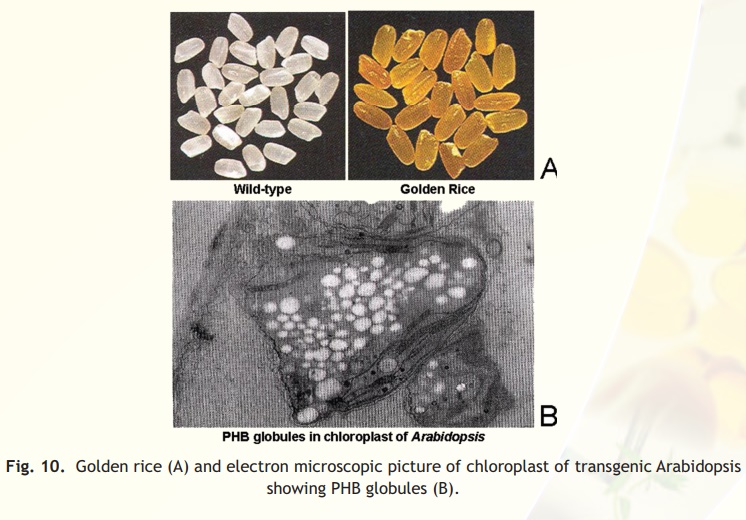
Seed protein quality: The nutritional quality of cereals and legumes are limited because ofdeficiency of the essential amino acids, i.e. lysine in cereals, and methionine and tryptophan in pulses. Two genetic engineering approaches have been used to improve the seed protein quality. In the first case, a transgene (e.g. gene for protein containing sulphur rich amino acids was introduced into pea plant (which is deficient in methionine and cysteine, but rich in lysine) under the control of seed-specific promoter. In the second approach, the endogenous genes are modified, so as to increase the essential amino acids like lysine in the seed proteins of cereals.
Diagnostic and therapeutic proteins
Transgenic plants can also produce a variety of proteins used in diagnostics for detecting human diseases and therapeutics for curing human and animal diseases in large-scale with low cost. The monoclonal antibodies, blood plasma proteins, peptide hormones and cytokinins are being produced in transgenic plants and their parts such as tobacco (in leaves), potato (in tubers), sugarcane (in stems) and maize (in seed endosperm).
Edible vaccines
Crop plants offer a cost-effective bioreactor to express antigens which can be used as edible vaccines. Some of the antigenic determinants on the surface of viruses and bacteria are proteins made by the pathogen. The genes encoding these antigenic proteins can be isolated from the pathogens and expressed in plants, and such transgenic plants or their tissues producing antigens can be eaten for vaccination/immunisation(edible vaccines). The expression of such antigenic proteins in crops like banana and tomato are useful for immunisation of humans since banana and tomato fruits can be eaten raw. In case of animals, such genes can be expressed in crops like alfalfa and other forage/fodder crops, which are suitable for vaccination. The edible vaccines that are produced in transgenic plants have great advantages like the alleviation of storage problems, easy delivery system by feeding and low cost as compared to the recombinant vaccines produced by bacterial fermentation. Vaccinating people against dreadful diseases like cholera and hepatitis B by feeding them banana/tomato, and vaccinating animals against important diseases such as foot and mouth disease by feeding them sugar beets could be a reality in the near future.
Biodegradable plastics
The biodegradable plastic, e.g. polyhydroxybutyrate (PHB) is being produced commercially by fermentation with the bacterium Alcaligeneseutrophus. The main drawback of bacterial PHB is its high production cost, making it substantially very expensive than synthetic plastics. Alternatively, transgenic plants can be used as factories to produce PHB. The genetically engineered Arabidopisis plants with the three genes involved in PHB synthesis from A. eutrophus produced PHB globules exclusively in their chloroplasts without effecting plant growth and development (Fig. 10B). The large-scale production of PHB may be easily achieved in tree plants like populus, where PHB can be extracted from leaves. Industry has already begun to explore the production of biodegradable plastics from transgenic plants.
Metabolic engineering and secondary products
Plant biotechnology will lead to improved plant sources for the production of valuable secondary metabolites mentioned in previous section on cell culture products. Biosynthetic pathway which lead to the production of such valuable products are being engineered for their over-production to reduce the cost. The over-expression of the gene, which encode for the first enzyme in a pathway generally results in higher levels of the desired end product, and this has been successfully done in the enhancement of taxol production from the transformed tissue cultures of Taxussp. Another strategy involves the use of Agrobacterium rhizogenesto induce the excessiveformation of secondary roots (hairy roots) in plants that normally produce useful secondary metabolites in this region.
Other applications
There are many other applications of plant genetic engineering, which are listed below:
• Production of healthy oils with altered fatty acid profiles.
• Modification of starch properties for specific uses.
• Favourable change of grain storage products and their chemical composition to improve the processing of bread making with wheat flour, malting of barley and brewing of beer.
• Removal of undesirable toxic compounds in certain plants.
• Development of blue roses (Fig. 11A), which is otherwise not possible by conventional plant breeding because of the absence of blue pigment in roses.
• Development of blue coloured cotton (Fig. 11B) and also with other colours.
• Development of tear-less onions, caffeine-free coffee and low nicotine tobacco.
Undoubtedly, there will be many more exciting applications of plant genetic engineering in the future.
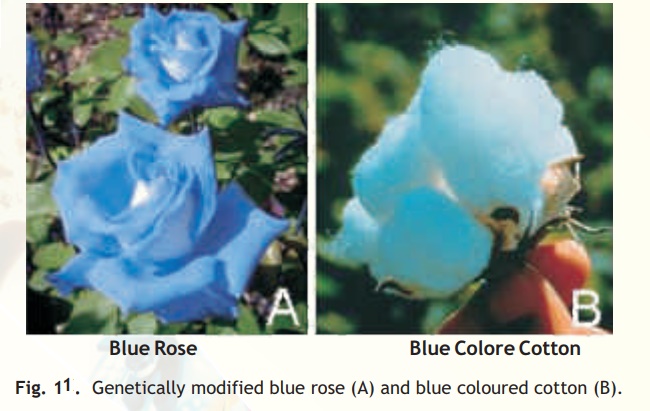
Related Topics